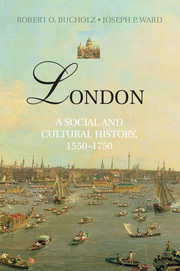Book contents
- Frontmatter
- Contents
- List of Illustrations and Maps
- List of Abbreviations and Conventions
- Acknowledgments
- Maps
- Introduction: London's Importance
- 1 London in 1550
- 2 The Socioeconomic Base
- 3 Royal and Civic London
- 4 Fine and Performed Arts
- 5 The Public Sphere and Popular Culture
- 6 The People on the Margins
- 7 Riot and Rebellion
- 8 Plague and Fire
- Conclusion: London in 1750
- Notes
- Further Reading
- Index
- Plate Section
Conclusion: London in 1750
Published online by Cambridge University Press: 05 November 2012
- Frontmatter
- Contents
- List of Illustrations and Maps
- List of Abbreviations and Conventions
- Acknowledgments
- Maps
- Introduction: London's Importance
- 1 London in 1550
- 2 The Socioeconomic Base
- 3 Royal and Civic London
- 4 Fine and Performed Arts
- 5 The Public Sphere and Popular Culture
- 6 The People on the Margins
- 7 Riot and Rebellion
- 8 Plague and Fire
- Conclusion: London in 1750
- Notes
- Further Reading
- Index
- Plate Section
Summary
The View from Highgate
People came to London in 1750 much as they did in 1550: by ship, in carriages, on horseback, on the back of a cart, or on foot, more or less along the same waterway and roads as before. Admittedly, travel had improved considerably for those at the upper end of society: ships were bigger, with better accommodation for well-paying passengers, and coach service between capital and countryside was now a standard amenity. But whether we are arriving by coach and six or hoofing it ourselves, our first sight of London would be just as startling as before. If, as in 1550, we came down Highgate Hill from the north, we would again see the metropolis laid out before us along the still silver thread of the Thames (see Illustration c.1). The city fills more of our peripheral vision now: its population having grown from 120,000 to nearly 700,000, London has advanced in all directions well beyond its three great bookends. To our left, the docks and maritime conurbation of the East End have crept past the bend in the river at the Isle of Dogs to Blackwall Reach. To our right, the Strand is now obscured by building, and the West End has been filled in to Hyde Park. Looking still farther west, we see that Notting Hill and Knightsbridge remain rural and green. Toward the horizon, the south bank has also filled in, but shallowly, greater London extending only about half a mile into Surrey at its deepest point. In the foreground, northern London has grown up to Tottenham Court, Lambe's Conduit Fields, and Shoreditch, a parish of 10,000 people anchored by George Dance's (c. 1694–1768) St. Leonard's church. From our elevated vantage point, we are instantly aware of the growth of suburbs and satellite communities like Newington, Mile End, Hackney, Shadwell, and Islington, tied to the capital by roads well maintained by the wealthy taxpayers of Middlesex, Essex, Kent, and Surrey. It was now possible for a successful merchant or a nobleman with London connections to do his business in the city, do his living in the country, and commute between the two by coach. The London season was, in 1750, porous and, if one preferred, a daily affair.
- Type
- Chapter
- Information
- LondonA Social and Cultural History, 1550–1750, pp. 332 - 368Publisher: Cambridge University PressPrint publication year: 2012

